|
Kryha
In the history of cryptography, the Kryha machine was a device for encryption and decryption, appearing in the early 1920s and used until the 1950s. The machine was the invention of Alexander von Kryha (born 31.10.1891 in Charkow, Russian Empire, committed suicide in Baden-Baden in 1955). During the Second World War, Kryha worked as an officer for the German Wehrmacht. There were several versions; the standard Kryha machine weighed around five kilograms, and was totally mechanical. A scaled down pocket version was introduced later on, termed the "Lilliput" model. There was also a more bulky electrical version. The machine was used for a time by the German Diplomatic Corps, and was adopted by Marconi in England. Operation The machine consisted of two concentric rings each containing an alphabet. The inner alphabet was stepped a variable number of places by pushing a lever. In operation, the user would encrypt by finding the plaintext letter on one ring (usually the outer ri ... [...More Info...] [...Related Items...] OR: [Wikipedia] [Google] [Baidu] |
Georg Hamel
Georg Karl Wilhelm Hamel (12 September 1877 – 4 October 1954) was a German mathematician with interests in mechanics, the foundations of mathematics and function theory. Biography Hamel was born in Düren, Rhenish Prussia. He studied at Aachen, Berlin, Göttingen, and Karlsruhe. His doctoral adviser was David Hilbert. He taught at Brünn in 1905, Aachen in 1912, and at the Technical University of Berlin in 1919. In 1927, Hamel studied the size of the key space for the Kryha encryption device. He was an Invited Speaker of the ICM in 1932 at Zurich and in 1936 at Oslo. He was the author of several important treatises on mechanics. He became a member of the Prussian Academy of Sciences in 1938 and the Bavarian Academy of Sciences in 1953. He died in Landshut, Bavaria. Selected publications * ("On the geometries in which the straight lines are the shortest", Hamel's doctoral dissertation on Hilbert's fourth problem. A version may be found in Mathematische Annalen 57, 190 ... [...More Info...] [...Related Items...] OR: [Wikipedia] [Google] [Baidu] |
Alphabet
An alphabet is a standardized set of basic written graphemes (called letters) that represent the phonemes of certain spoken languages. Not all writing systems represent language in this way; in a syllabary, each character represents a syllable, and logographic systems use characters to represent words, morphemes, or other semantic units. The first fully phonemic script, the Proto-Sinaitic script, later known as the Phoenician alphabet, is considered to be the first alphabet and is the ancestor of most modern alphabets, including Arabic, Cyrillic, Greek, Hebrew, Latin, and possibly Brahmic. It was created by Semitic-speaking workers and slaves in the Sinai Peninsula (as the Proto-Sinaitic script), by selecting a small number of hieroglyphs commonly seen in their Egyptian surroundings to describe the sounds, as opposed to the semantic values of the Canaanite languages. However, Peter T. Daniels distinguishes an abugida, a set of graphemes that represent consonantal base let ... [...More Info...] [...Related Items...] OR: [Wikipedia] [Google] [Baidu] |
Abraham Sinkov
Abraham Sinkov (August 22, 1907 – January 19, 1998) was a US cryptanalyst. An early employee of the U.S. Army's Signals Intelligence Service, he held several leadership positions during World War II, transitioning to the new National Security Agency after the war, where he became a deputy director. After retiring in 1962, he taught mathematics at Arizona State University. Biography Sinkov was the son of Jewish immigrants Morris (Mordechai Eliezer) and Ethel (née Etel Constantinowsky) from Alexandria, Russia, which is now Oleksandriya, Kirovohrad Oblast, Ukraine. Sinkov was born in Philadelphia, but grew up in Brooklyn. After graduating from Boys High School he took his B.S. in mathematics from City College of New York. (By coincidence, one of his close friends at Boys High and CCNY was Solomon Kullback). Mr. Sinkov taught in New York City schools but was unhappy with the working conditions and anxious to use his mathematics knowledge in practical ways. Early career The ... [...More Info...] [...Related Items...] OR: [Wikipedia] [Google] [Baidu] |
Frank Rowlett
Frank Byron Rowlett (May 2, 1908 – June 29, 1998) was an American cryptologist. Life and career Rowlett was born in Rose Hill, Lee County, Virginia and attended Emory & Henry College in Emory, Virginia. In 1929 he received a bachelor's degree in mathematics and chemistry. He was hired by William Friedman as a "junior cryptanalyst" for the Signals Intelligence Service (SIS) on April Fools' Day 1930; shortly after, he was followed into SIS by Abraham Sinkov and Solomon Kullback. During the 1930s, after a lengthy period of training, Rowlett and his colleagues compiled codes and ciphers for use by the U.S. Army and began solving a number of foreign, notably Japanese, systems. In the mid-1930s, they solved the first Japanese machine for encipherment of diplomatic communications, known to the Americans as RED. In 1939–40, Rowlett led the SIS effort that solved a more sophisticated Japanese diplomatic machine cipher, codenamed PURPLE by the U.S. Once, when asked what ... [...More Info...] [...Related Items...] OR: [Wikipedia] [Google] [Baidu] |
Solomon Kullback
Solomon Kullback (April 3, 1907August 5, 1994) was an American cryptanalyst and mathematician, who was one of the first three employees hired by William F. Friedman at the US Army's Signal Intelligence Service (SIS) in the 1930s, along with Frank Rowlett and Abraham Sinkov. He went on to a long and distinguished career at SIS and its eventual successor, the National Security Agency (NSA). Kullback was the Chief Scientist at the NSA until his retirement in 1962, whereupon he took a position at the George Washington University. The Kullback–Leibler divergence is named after Kullback and Richard Leibler. Life and career Kullback was born to Jewish parents in Brooklyn, New York. His father Nathan had been born in Vilna, Russian Empire, (now Vilnius, Lithuania) and had immigrated to the US as a young man circa 1905, and became a naturalized American in 1911. Kullback attended Boys High School in Brooklyn. He then went to City College of New York, graduating with a BA in 1927 an ... [...More Info...] [...Related Items...] OR: [Wikipedia] [Google] [Baidu] |
William Friedman
William Frederick Friedman (September 24, 1891 – November 12, 1969) was a US Army cryptographer who ran the research division of the Army's Signal Intelligence Service (SIS) in the 1930s, and parts of its follow-on services into the 1950s. In 1940, subordinates of his led by Frank Rowlett broke Japan's PURPLE cipher, thus disclosing Japanese diplomatic secrets before America's entrance into World War II. Early life Friedman was born Wolf Friedman ( yi, װאָלףֿ פֿרידמאַן, russian: Вольф Ф. Фридман), in Chişinău, Bessarabia, the son of Frederick Friedman, a Jew from Bucharest who worked as a translator and linguist for the Russian Postal Service, and the daughter of a well-to-do wine merchant. Friedman's family fled Russia in 1892 to escape the virulent anti-Semitism there, ending up in Pittsburgh, Pennsylvania. Three years later, his first name was changed to William. As a child, Friedman was introduced to cryptography in the short story " The ... [...More Info...] [...Related Items...] OR: [Wikipedia] [Google] [Baidu] |
Key (cryptography)
A key in cryptography is a piece of information, usually a string of numbers or letters that are stored in a file, which, when processed through a cryptographic algorithm, can encode or decode cryptographic data. Based on the used method, the key can be different sizes and varieties, but in all cases, the strength of the encryption relies on the security of the key being maintained. A key’s security strength is dependent on its algorithm, the size of the key, the generation of the key, and the process of key exchange. Scope The key is what is used to encrypt data from plaintext to ciphertext. There are different methods for utilizing keys and encryption. Symmetric cryptography Symmetric cryptography refers to the practice of the same key being used for both encryption and decryption. Asymmetric cryptography Asymmetric cryptography has separate keys for encrypting and decrypting. These keys are known as the public and private keys, respectively. Purpose Since the ... [...More Info...] [...Related Items...] OR: [Wikipedia] [Google] [Baidu] |
Plaintext
In cryptography, plaintext usually means unencrypted information pending input into cryptographic algorithms, usually encryption algorithms. This usually refers to data that is transmitted or stored unencrypted. Overview With the advent of computing, the term ''plaintext'' expanded beyond human-readable documents to mean any data, including binary files, in a form that can be viewed or used without requiring a key or other decryption device. Information—a message, document, file, etc.—if to be communicated or stored in an unencrypted form is referred to as plaintext. Plaintext is used as input to an encryption algorithm; the output is usually termed ciphertext, particularly when the algorithm is a cipher. Codetext is less often used, and almost always only when the algorithm involved is actually a code. Some systems use multiple layers of encryption, with the output of one encryption algorithm becoming "plaintext" input for the next. Secure handling Insecure handling o ... [...More Info...] [...Related Items...] OR: [Wikipedia] [Google] [Baidu] |
Concentric
In geometry, two or more objects are said to be concentric, coaxal, or coaxial when they share the same center or axis. Circles, regular polygons and regular polyhedra, and spheres may be concentric to one another (sharing the same center point), as may cylinders (sharing the same central axis). Geometric properties In the Euclidean plane, two circles that are concentric necessarily have different radii from each other.. However, circles in three-dimensional space may be concentric, and have the same radius as each other, but nevertheless be different circles. For example, two different meridians of a terrestrial globe are concentric with each other and with the globe of the earth (approximated as a sphere). More generally, every two great circles on a sphere are concentric with each other and with the sphere. By Euler's theorem in geometry on the distance between the circumcenter and incenter of a triangle, two concentric circles (with that distance being zero) are ... [...More Info...] [...Related Items...] OR: [Wikipedia] [Google] [Baidu] |
History Of Cryptography
Cryptography, the use of codes and ciphers to protect secrets, began thousands of years ago. Until recent decades, it has been the story of what might be called classical cryptography — that is, of methods of encryption that use pen and paper, or perhaps simple mechanical aids. In the early 20th century, the invention of complex mechanical and electromechanical machines, such as the Enigma rotor machine, provided more sophisticated and efficient means of encryption; and the subsequent introduction of electronics and computing has allowed elaborate schemes of still greater complexity, most of which are entirely unsuited to pen and paper. The development of cryptography has been paralleled by the development of cryptanalysis — the "breaking" of codes and ciphers. The discovery and application, early on, of frequency analysis to the reading of encrypted communications has, on occasion, altered the course of history. Thus the Zimmermann Telegram triggered the United States' ... [...More Info...] [...Related Items...] OR: [Wikipedia] [Google] [Baidu] |




